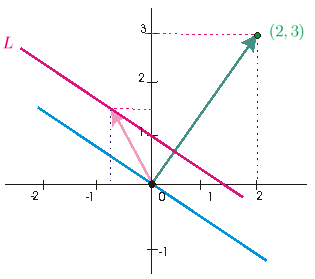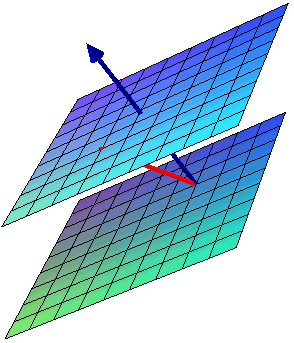Hyperplane – Illustration
Here we illustrate a hyperplane in \(\RNrSpc{2}\) or in \(\RNrSpc{3}\).
A hyperplane in
\(\RNrSpc{2}\)
is just a line

In the picture above, the blue line is the hyperspace which is perpendicular to the green normal vector. The red line \(L\) is a hyperplane. It results from parallel translating the blue hyperspace.
An equation for the hyperspace (blue) is
\[\DotPr{(2,3)}{(x,y)} = 2x + 3y = 0\]
An equation for the hyperplane (red) is
| \(2x+3y\) | \(=\) | \(3\) |
| \(\DotPr{ (2,3) }{(x,y)}\) | \(=\) | \(\DotPr{ (2,3) }{ (0,1) }\) |
A hyperplane in
\(\RNrSpc{3}\)
is just a plane in the usual sense

In the picture above, the planes are hyperplanes in 3-space. The tail of the two arrows is supposed to be at the origin. So the lower hyperplane passes through the origin and, hence, is even a hyperspace. In general, we characterize the location of a hyperplane by specifying a vector \(\Vect{a}\) (blue) perpendicular to it and by specifying a point on it (the tip of the red arrow). Alternatively, we can think of a hyperplane as being obtained by parallel translating the hyperspace which is perpendicular to \(\Vect{a}\) off of the origin by a suitable vector (red).
If \(\Vect{a} = (a,b,c)\), then an equation for the hyperspace
\[\DotPr{(a,b,c)}{(x,y,z)} = ax + by + cz = 0\]
If the hyperplane passes through the point \(P(p,q,r)\) (with red position vector), then an equation for the hyperplane is
| \(ax + by + cz\) | \(=\) | \(ap+bq+cr\) |
| \(\DotPr{(a,b,c)}{(x,y,z)}\) | \(=\) | \(\DotPr{(a,b,c)}{(p,q,r)}\) |
Hyperplane – Illustration

